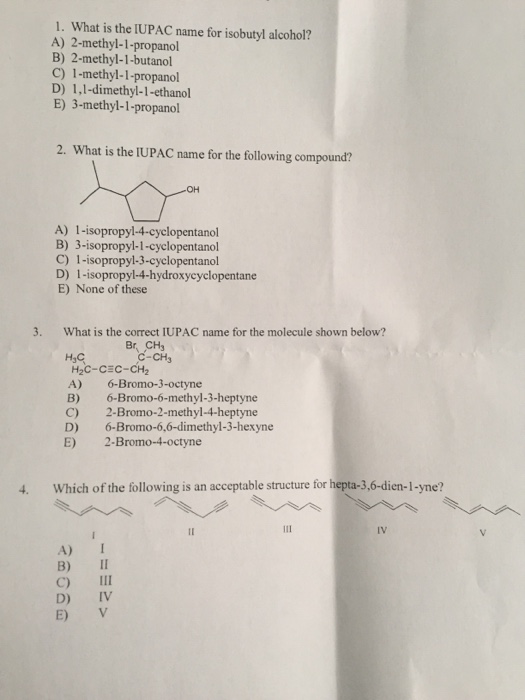The IUPAC nomenclature system is the standard system used by chemists to name organic compounds. With the IUPAC system, it is possible to determine the structure of a compound based solely on its name. In this article, we’ll explore the IUPAC name for isobutyl alcohol and its uses in the chemical industry.
Contents
What is the IUPAC System for Naming Isobutyl Alcohol?
Isobutyl alcohol, also known as 2-methyl-1-propanol, is an organic compound consisting of four carbon atoms and eight hydrogen atoms. The International Union of Pure and Applied Chemistry (IUPAC) system is an accepted method of naming organic molecules and it is based on a specific set of rules. The IUPAC name for isobutyl alcohol is 2-methylpropan-1-ol.
How the IUPAC Naming System Works
The IUPAC system assigns a unique name to each organic compound by specifying the number and arrangement of the atoms within the molecule. A primary purpose of the system is to ensure that each compound has a unique name that accurately describes its chemical structure. The IUPAC name for a compound begins by identifying the longest continuous chain of carbon atoms. This chain is then numbered from one end to the other and the substituents (other atoms or groups of atoms) are then named.
For example, isobutyl alcohol has four carbon atoms arranged in a chain, so it is classified as a butanol. The carbon atoms in the chain are numbered from the end closest to the substituent – in this case, the methyl group – and the name assigned is 2-methylpropan-1-ol. The “2” identifies the position of the methyl group, the “propan” identifies the three-carbon chain and the “1-ol” indicates that the compound is an alcohol.
The Properties and Uses of Isobutyl Alcohol
Isobutyl alcohol has a variety of uses including as a solvent, a fuel additive and a chemical intermediate. It is a clear, colorless liquid with a pungent odor and a sweet taste. It is miscible with water and is slightly soluble in most organic solvents. It has a boiling point of 108°C and a flash point of 30°C.
Isobutyl alcohol is often used as a solvent for paints, resins and inks. It is also used in the manufacture of cosmetics, pharmaceuticals, explosives and herbicides. It is an effective fuel additive and is used to improve the combustion of gasoline and to reduce emissions from engines.
Safety Concerns
Isobutyl alcohol is flammable and can be hazardous if inhaled or ingested. It can irritate the eyes, skin and respiratory system and long-term exposure can cause liver and kidney damage. Protective equipment such as goggles, gloves and respirators should be worn when handling isobutyl alcohol.
Environmental Impact
Isobutyl alcohol is not very toxic to aquatic organisms and it is not expected to persist in the environment. However, it can be toxic to some species and its release into water should be minimized. The use of isobutyl alcohol can also contribute to air pollution, so it should be used in enclosed areas with extractor fans.
Frequently Asked Questions
What is the IUPAC Name for Isobutyl Alcohol?
Answer: The IUPAC name for isobutyl alcohol is 2-methylpropan-1-ol.
What is an IUPAC Name?
Answer: The International Union of Pure and Applied Chemistry (IUPAC) name is a systematic way of naming organic compounds. It is a standard way of naming molecules and chemical compounds according to their structure and composition. IUPAC names are made up of several parts, including the root name, which indicates the number of carbon atoms in the molecule, the suffix, which indicates the type of compound, and the prefix, which indicates the functional group.
What is Isobutyl Alcohol?
Answer: Isobutyl alcohol is an organic compound with the molecular formula C4H10O. It is a four-carbon branched-chain saturated alcohol. It is a colourless liquid with a slightly sweet odour and is miscible with most organic solvents. Isobutyl alcohol is used as a solvent in many industrial and commercial applications.
What is the Chemical Formula of Isobutyl Alcohol?
Answer: The chemical formula for isobutyl alcohol is C4H10O. It is a four-carbon branched-chain saturated alcohol with the molecular formula C4H10O.
What are the Uses of Isobutyl Alcohol?
Answer: Isobutyl alcohol is used in many industrial and commercial applications as a solvent. It is used as a solvent in the production of varnishes, lacquers, and inks. It is also used in the manufacture of pharmaceuticals, dyes, flavorings, and perfumes. In addition, isobutyl alcohol is used as a fuel additive and as a cleaner for certain types of plastics.
What is the Boiling Point of Isobutyl Alcohol?
Answer: The boiling point of isobutyl alcohol is 116°C (240°F). At atmospheric pressure, isobutyl alcohol will boil at a temperature of 116°C (240°F). It is a colourless liquid with a slightly sweet odour and is miscible with most organic solvents.
The Iupac name for Isobutyl Alcohol is 2-methylpropan-1-ol. It is a clear, colorless, and flammable liquid with a characteristic odor. With its high boiling point and low vapor pressure, Isobutyl Alcohol is often used as a solvent in various industries. It is also used as a fuel blending component and as an ingredient in manufacturing perfumes and flavors. With its many practical uses and applications, Isobutyl Alcohol is an important compound in modern day chemistry.


